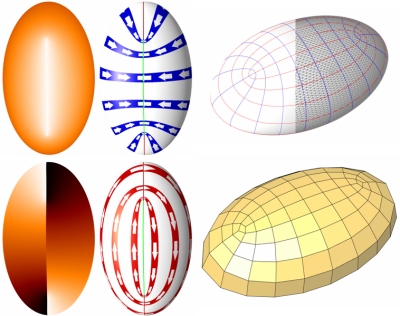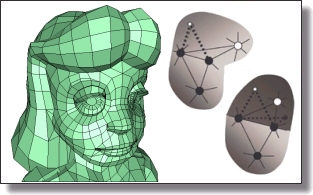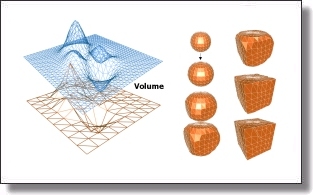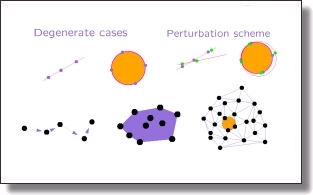
Optimizing Voronoi Diagrams for Polygonal
Finite Element Computations
Daniel Sieger, Pierre Alliez and Mario Botsch
Proceedings of the 19th International Meshing Roundtable, 2010.
Abstract: We present a 2D mesh improvement technique that optimizes Voronoi diagrams for their use in polygonal nite element computations. Starting from a centroidal Voronoi tessellation of the simulation domain we optimize the mesh by minimizing a carefully designed energy functional that effectively removes the major reason for numerical instabilities: short edges in the Voronoi diagram. We evaluate our method on a 2D Poisson problem and demonstrate that our simple but e ective optimization achieves a significant improvement of the stiffness matrix condition number.

Patrick Mullen, Fernando de Goes, Mathieu Desbrun, David Cohen-Steiner and Pierre Alliez.
EUROGRAPHICS Symposium on Geometry Processing 2010.
Abstract: We propose a modular framework for robust 3D reconstruction from unorganized, unoriented, noisy, and outlierridden geometric data. We gain robustness and scalability over previous methods through an unsigned distance approximation to the input data followed by a global stochastic signing of the function. An isosurface reconstruction is finally deduced via a sparse linear solve. We show with experiments on large, raw, geometric datasets that this approach is scalable while robust to noise, outliers, and holes. The modularity of our approach facilitates customization of the pipeline components to exploit specific idiosyncracies of datasets, while the simplicity of each component leads to a straightforward implementation.

Jane Tournois, Camille Wormser, Pierre Alliez and Mathieu Desbrun
ACM Transactions on Graphics (SIGGRAPH), 28(3), 2009.
Abstract: We present a practical approach to isotropic tetrahedral meshing of 3D domains bounded by piecewise smooth surfaces. Building upon recent theoretical and practical advances, our algorithm interleaves Delaunay refinement and mesh optimization to generate quality meshes that satisfy a set of user-defined criteria. This interleaving is shown to be more conservative in number of Steiner point insertions than refinement alone, and to produce higher quality meshes than optimization alone. A careful treatment of boundaries and their features is presented, offering a versatile framework for designing smoothly graded tetrahedral meshes.
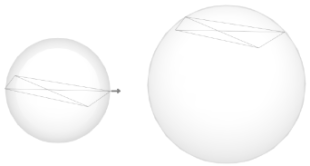
Perturbing Slivers in 3D Delaunay Meshes
Jane Tournois, Rahul Srinivasan and Pierre Alliez
International Meshing Roundtable 2009.
Abstract: Isotropic tetrahedron meshes generated by Delaunay triangulations are known to contain a majority of well-shaped tetrahedra, as well as spurious sliver tetrahedra. As the slivers hamper stability of numerical simulations we aim at removing them while keeping the triangulation Delaunay for simplicity. The solution which explicitly perturbs the slivers through random vertex relocation and Delaunay connectivity update is very effective but slow. In this paper we present a perturbation algorithm which favors deterministic over random perturbation. The added value is an improved efficiency and effectiveness. Our experimental study applies the proposed algorithm to meshes obtained by Delaunay refinement as well as to carefully optimized meshes.

Filtering Relocations on a Delaunay Triangulation
Pedro Machado, Jane Tournois, Pierre Alliez and Olivier Devillers
EUROGRAPHICS Symposium on Geometry Processing 2009.
Abstract: Updating a Delaunay triangulation when its vertices move is a bottleneck in several domains of application. Rebuilding the whole triangulation from scratch is surprisingly a very viable option compared to relocating the vertices. This can be explained by several recent advances in efficient construction of Delaunay triangulations. However, when all points move with a small magnitude, or when only a fraction of the vertices move, rebuilding is no longer the best option. This paper considers the problem of efficiently updating a Delaunay triangulation when its vertices are moving under small perturbations. The main contribution is a set of filters based upon the concept of vertex tolerances. Experiments show that filtering relocations is faster than rebuilding the whole triangulation from scratch under certain conditions.

Pierre Alliez, Andreas Fabri, Efi Fogel.
SIGGRAPH 2008 course notes (pdf)

Spectral Conformal Parameterization (pdf)
Patrick Mullen, Yiying Tong, Pierre Alliez and Mathieu Desbrun.
Symposium on Geometry Processing, 2008.
We present a spectral approach to automatically and efficiently obtain discrete free-boundary conformal parameterizations of triangle mesh patches, without the common artifacts due to positional constraints on vertices and without undue bias introduced by sampling irregularity. High-quality parameterizations are computed through a constrained minimization of a discrete weighted conformal energy by finding the largest eigenvalue/eigenvector of a generalized eigenvalue problem involving sparse, symmetric matrices. We demonstrate that this novel and robust approach improves on previous linear techniques both quantitatively and qualitatively.

Mario Botsch, Mark Pauly, Leif Kobbelt, Pierre Alliez, Bruno Levy, Stephan Bischoff, Christian Rössl.
Eurographics 2008 Course Notes.

Pierre Alliez, David Cohen-Steiner, Yiying Tong, and Mathieu Desbrun. Symposium on Geometry Processing, 2007, pages 39-48. (best paper award)
Download slides (ppt format)
Abstract: We introduce an algorithm for reconstructing watertight surfaces from unoriented point sets. Using the Voronoi diagram of the input point set, we deduce a tensor field whose principal axes and eccentricities locally represent respectively the most likely direction of the normal to the surface, and the confidence in this direction estimation. An implicit function is then computed by solving a generalized eigenvalue problem such that its gradient is most aligned with the principal axes of the tensor field, providing a best-fitting isosurface reconstruction. Our approach possesses a number of distinguishing features. In particular, the implicit function optimization provides resilience to noise, adjustable fitting to the data, and controllable smoothness of the reconstructed surface. Finally, the use of simplicial meshes (possibly restricted to a thin crust around the input data) and (an)isotropic Laplace operators renders the numerical treatment simple and robust.

SIGGRAPH 2007 Course Notes (award for the best revised course notes)

Jane Tournois, Pierre Alliez and Olivier Devillers
16th International Meshing Roundtable
Abstract: We address the problem of generating 2D quality triangle meshes from a set of constraints provided as a planar straight line graph. The algorithm first computes a constrained Delaunay triangulation of the input set of constraints, then interleaves Delaunay refinement and optimization. The refinement stage inserts a subset of the Voronoi vertices and midpoints of constrained edges as Steiner points. The optimization stage optimizes the shape of the triangles through the Lloyd iteration applied to Steiner points both in 1D along constrained edges and in 2D after computing the bounded Voronoi diagram. Our experiments show that the proposed algorithm inserts fewer Steiner points than Delaunay refinement alone, and improves over the mesh quality.

Mesh Sizing with Additively Weighted Voronoi Diagrams
Lakulish Antani, Christophe Delage and Pierre Alliez
16th International Meshin Roundtable
Abstract: We address the problem of generating mesh sizing functions from a set of points with specified sizing values. The sizing functions are shown to be maximal and K-Lipschitz, with arbitrary parameter K provided by the user. These properties allow generating low complexity meshes with adjustable gradation. After constructing an additively weighted Voronoi diagram, our algorithm provides fast and accurate answers to arbitrary point queries. We have implemented our mesh sizing technique as a sizing criterion for the 2D triangle meshing component from the CGAL library. We demonstrate the performance advantages of our technique through experimental results on various inputs.
